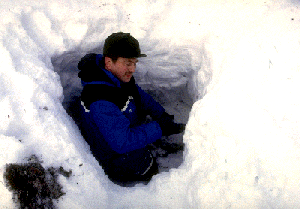Topsoil
Rationale
Topsoil (Fig. 1) is defined here as the upper 5 cm of soil below the living
plant material (0-5 cm). It often consists of, or at least contains,
organic material, which binds up deposited heavy metals and many
other elements very efficiently. Higher plants take up many of their
nutrients from the topsoil, and also pick up contaminants in the
process. Thus, topsoil chemistry influences the quality of
the food chain. By collecting topsoil at several
times throughout the year (including in winter, as frozen topsoil, see Fig. 2),
one can get an idea of the seasonal dynamics of this binding capacity.
Advantages
Very simple and cheap to sample.
Drawbacks
Composition varies from exclusively organic (humus) to partly
organic and partly minerogenic.
High spatial variability requires sampling of many subsamples
at any one location.
TOPSOIL CORER
![[Kola logo]](/Kola/topsoil_.gif)
(Photo: C. Reimann)
Fig. 1: The topsoil corer (auger) was especially designed and constructed for
the Kola Project. It allows easy collection of a topsoil sample of approx.
10 cm diameter. The topsoil core is shown here (left) before being trimmed
to the standard 0-5 cm size (the layer of living material has been removed
and can be seen leaning against the core at the front right of it).
|
FROZEN TOPSOIL SAMPLE

(Photo: C. Reimann)
Fig. 2: Collecting a frozen topsoil sample in winter.
|



![[Kola logo]](/Kola/topsoil_.gif)



